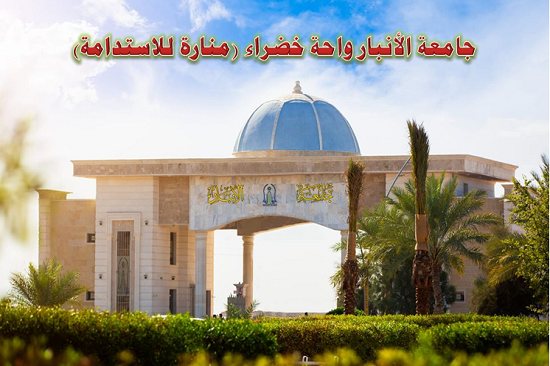|
University of Anbar Green Oasis Project: A Beacon of Sustainability
2024-07-22

Researchers from the Upper Euphrates Basin Developing Centre at the University of Anbar published a pioneering study in the proceedings of the International Conference on Environment and Sustainability 2023, which was held at the University of Anbar, which was entitled: (International Conference on Environment and Sustainability ICES 2023), the study highlighted the great positive impact of the " University of Anbar Green Oasis" project on local vegetation cover, the study was conducted by: (Dr. Haitham Abdel Mohsen Afen, Prof. Dr. Ammar Hatem Kamel, Dr. Bashir Khalil Ibrahim, and Dr. Atheer Salim Al-Mawla), and the study showed the effectiveness of remote sensing and satellite images in monitoring environmental changes.
The University of Anbar has made great strides in the field of environmental sustainability with its ambitious project “University of Anbar is a Green Oasis". This initiative was launched in 2021, with the aim of transforming the university's site into a lush green space, and addressing critical issues such as climate change and air pollution.
The main objective of the research was to monitor and follow up the vegetation cover and drought conditions at the University of Anbar, where the study used multiple indicators to assess the environmental impact of the "Green Oasis" project, and showed that the project had a positive impact on the vegetation cover at the university site, despite the different humidity indicators, and the vegetation cover indicators also showed a significant improvement, indicating that the area maintains better vegetation cover over time. The study highlighted significant increases in green space and plant health, which are crucial for mitigating the effects of climate change and improving air quality.
The research was carried out in two phases: data collection and statistical analysis using satellite imagery from Sentinel-2 L2A to collect data over a five-year period (2018-2023). The study used the Anderson-Darling Normal Deviation Test and Trend Analysis to assess changes in vegetation.
Key statistics from the study included:
- A 220% increase in green spaces on campus, from 22,575 m² to 49,600 m². - Significant increases in green spaces in various faculties, including dentistry (increase by 724%), medicine (increase by 153%), and agriculture (increase by 365%).
- Significant increases in green spaces in various faculties, including dentistry (increase by 724%), medicine (increase by 153%), and agriculture (increase by 365%).
The results confirm the effectiveness of the Green Oasis project in enhancing vegetation cover and addressing environmental challenges. Finally, this study is a successful model for similar afforestation campaigns in arid and semi-arid areas, and provides valuable data for future research and sustainable development initiatives, and the researchers expressed their support for this type of project as the project not only enhances the quality of life for students and employees, but also serves as an example for other institutions seeking to achieve a greener and more sustainable future. Search link to view the study:
https://link.springer.com/chapter/10.1007/978-3-031-57054-4_6
#university_of_anbar
#Upper_Euphrates_Basin_Developing_Center
 |